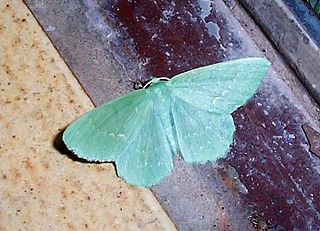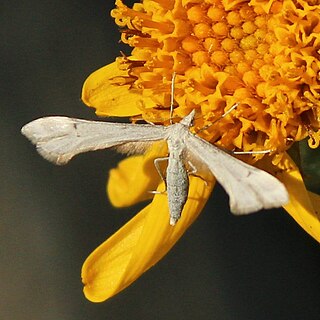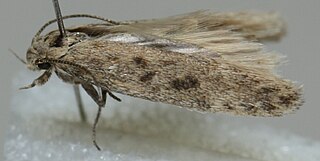
The large emerald is a moth which is the type species for the family Geometridae. It is found throughout the Palearctic region and the Near East in and around deciduous forests, heathlands, marshland and in settlements close to woodland. The species was first described by Carl Linnaeus in his 1758 10th edition of Systema Naturae.

The mottled umber is a moth of the family Geometridae. It is common throughout much of the Palearctic region. The species was first described by Carl Alexander Clerck in 1759.

Gillmeria albertae is a moth of the family Pterophoridae first described by William Barnes and Arthur Ward Lindsey in 1921. It is known from the mountains of Alberta near Banff.

Scrobipalpa obsoletella, the summer groundling, is a moth of the family Gelechiidae. It is found in most of Europe, Turkey, the Caucasus, from Iran to Asian Russia (Transbaikal) and Mongolia. It has also been recorded from New Zealand, South Africa and North America, where it is probably an introduced species. The habitat consists of coastal salt marshes and sandy beaches.
Elachista texanica is a moth of the family Elachistidae. It is found in the United States, where it has been recorded from Texas.
Elachista solitaria is a moth of the family Elachistidae. It is found in the United States, where it has been recorded from Florida, Kentucky and Ohio.
Helcystogramma adaequata is a moth in the family Gelechiidae. It was described by Edward Meyrick in 1914. It is found in Guyana.
Helcystogramma casca is a moth in the family Gelechiidae. It was described by Annette Frances Braun in 1925. It is found in North America, where it has been recorded from southern Saskatchewan and British Columbia to Utah, Colorado and Oregon.
Helcystogramma lyrella is a moth in the family Gelechiidae. It was described by Walsingham in 1911. It is found in Guatemala.
Helcystogramma fiscinata is a moth in the family Gelechiidae. It was described by Edward Meyrick in 1918. It is found in South Africa.

Helcystogramma melanocarpa is a moth in the family Gelechiidae. It was described by Edward Meyrick in 1929. It is found in North America, where it has been recorded from Nova Scotia to New Brunswick to South Carolina and to Texas.
Helcystogramma melantherella is a moth in the family Gelechiidae. It was described by August Busck in 1900. It is found in North America, where it has been recorded from North Carolina south to Florida and west to Texas and Arkansas.
Helcystogramma thesmiopa is a moth in the family Gelechiidae. It was described by Edward Meyrick in 1922. It is found in Pará, Brazil.
Sinoe capsana is a moth of the family Gelechiidae. It is found in North America, where it has been recorded from southern Florida.

Sinoe chambersi is a moth of the family Gelechiidae. It is found in North America, where it has been recorded from the United States and from Canada.
Sinoe kwakae is a moth of the family Gelechiidae. It is found in North America, where it has been recorded from Louisiana to Florida.
Scrobipalpula erigeronella is a moth in the family Gelechiidae. It was described by Annette Frances Braun in 1921. It is found in North America, where it has been recorded from Montana.
Anacampsis triangularis is a moth of the family Gelechiidae. It was described by Annette Frances Braun in 1923. It is found in North America, where it has been recorded from southern California.
Monochroa robusta is a moth of the family Gelechiidae. It was described by Annette Frances Braun in 1921. It is found in North America, where it has been recorded from Ohio and South Carolina.

Macronoctua onusta, commonly known as the iris borer, is a species of cutworm or dart moth in the family Noctuidae. It is found in North America.






